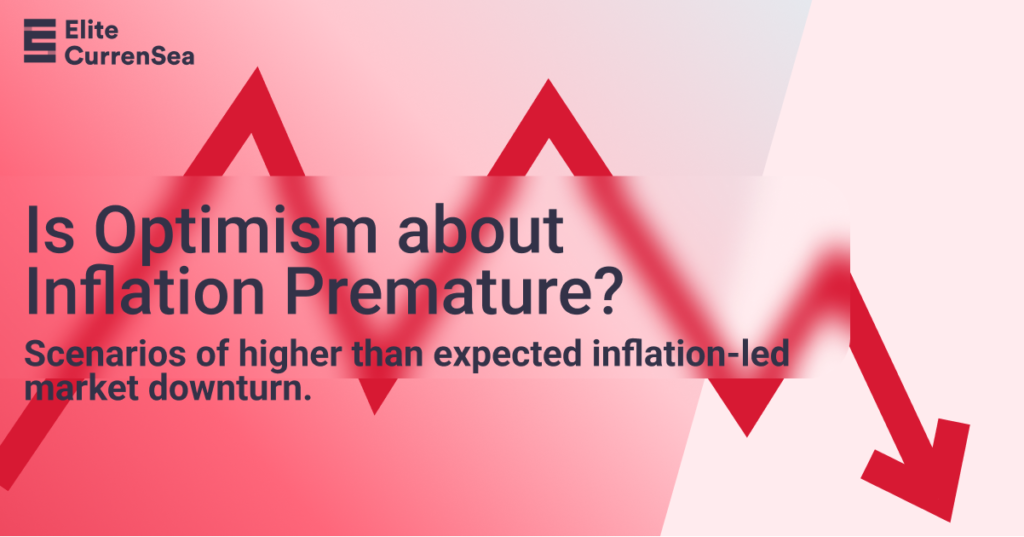Is the Market Too Optimistic About Subsiding Inflation?

By understanding why market optimism may be premature and exploring the implications of higher inflation, you’ll be able to make informed decisions and take the necessary steps to protect your portfolio. So don’t miss this opportunity to gain insight into how inflation could affect your investments – read on now!
Are you worried that market optimism around subsiding inflation is misguided? If so, you’re not alone. Inflation has started to come down from its 40 year high – but it could still take much longer than expected for prices to settle back into a more normal range.
In this blog post we’ll explore three big reasons why inflation could stay higher for longer and how it could affect your portfolio. We’ll also discuss what measures you can take to make sure your investments remain protected against unexpected price increases. Read on to find out more!
- Examine the causes of higher inflation and its potential effects
- Learn why market optimism may be premature and what it means for you
- Uncover the implications of higher inflation on your portfolio
- Discover the latest strategies to protect investments from unexpected price increases.
- Get tips on limiting the impact of inflation on your finances.
By understanding why market optimism may be premature and exploring the implications of higher inflation, you’ll be able to make informed decisions and take the necessary steps to protect your portfolio.
So don’t miss this opportunity to gain insight into how inflation could affect your investments – read on now!
China’s reopening could fuel global inflation
Traders, be aware of an unwelcome side effect of the recent easing of Covid restrictions in China that could have a big impact on your investing strategy: higher global inflation. This means traders should remain cautious when it comes to investing in stock markets and commodities in 2023. Bloomberg Economics forecasted that if China’s economy grows by 5.8% this year, it could lead to:
- A 1 percentage point rise in global inflation by the fourth quarter of 2023;
- A boost to global growth;
- An increase in energy prices.
If China’s economy grows even faster at 6.7%, then the effects on global inflation will be even greater. It is important to be aware of these possible outcomes and plan accordingly when it comes to investing in stock markets and commodities.
Strong real income growth could lead to spiraling inflation
Now, in the current macro environment, where we’re already starting off from a high base (i.e. inflation is already quite elevated), perhaps we don’t get the extreme scenario of hyperinflation – but these dynamics could push inflation to remain stubbornly high.}
Traders should stay wary of inflation as they consider investing in equities. Despite an impressive 517,000 jobs being added to the US economy in January, pushing wages higher and unemployment down to a 53-year low, there is still a risk that rising wages could outpace consumer prices and lead to spiraling inflation.
This could mean that businesses have to raise their prices, in turn pushing workers to demand even higher wages, resulting in inflation becoming increasingly difficult to contain. For traders considering investing in equities, it’s important to be aware of the possible effects of inflation and how it might affect returns on their investments.
Here are some key points to consider:
- Inflation is already quite elevated, though hyperinflation is not necessarily a given
- Real hourly earnings are finally rising after two years of no growth
- With more job openings than unemployed people in the US, wages are continuing to increase
- Companies may have to raise prices in order to offset their higher wage costs.
- Rising wages and prices can lead to a loop of spiraling inflation.
- Traders should be aware of the possible effects of inflation when investing in equities.
- It’s important to consider how inflation might affect returns on investments.
- Be prepared for the possibility of higher consumer prices going forward.
It’s important for traders to be aware of the potential effects of inflation on their investments and make informed decisions about where to put their money.
Though it’s difficult to predict exactly how high consumer prices could go, it’s important to remain vigilant and stay up-to-date with changes in the market.
By keeping an eye on inflation and basing investment decisions on sound financial predictions, traders can protect their portfolios from the potential impacts of rising prices.
Inflation is also a factor to consider when crafting an overall investment strategy for the future. Investing in assets that may be able to withstand higher consumer prices, such as commodities and real estate, could be a smart move. Additionally, looking into bonds and other fixed income investments may also be worthwhile as these can offer protection against inflationary pressures.
In the end, it’s important to remember that inflation affects everyone differently. It’s important to consider your own personal financial situation when determining an appropriate risk level when investing
High inflation has a way of being sticky
History serves to remind us that once the “inflation genie” has been set loose, reining him in can be an incredibly long and arduous process. As an example, the last time the United States saw double digit inflation was in the ’70s and ’80s. When Paul Volcker became Federal Reserve (Fed) Chair in 1979, he raised interest rates to an unparalleled 20%, which was a whopping five percent higher than the most elevated inflation rate at the time.
Nowadays, an increase in interest rates is arguably one of the most effective measures to counter inflation.
It took a gargantuan effort of two years for the extreme policy intervention to reduce inflation to merely half of its highest level – a mere 7% – and an extended period of six years to bring it to the bank’s long-term target of 2%.
Throughout time, many countries have seen a similar pattern play out; a study conducted by Research Affiliates examined cases in which inflation surged over 4% in 14 developed-economy countries between 1970 and 2022. Their conclusion? Getting back to a 3% rate of inflation is easy when it starts at 4%, much more difficult when it reaches 6%, and an overwhelming task if it surpasses 8%. On average, returning to 3% inflation from a rate of 8% or more requires over 10 years of effort.
What does all this mean for markets?
It looks like inflation isn’t slowing down any time soon, making it difficult for the Fed to hit the brakes on their rate-hiking cycle that the public has been expecting. As a result, it’s likely that interest rates will rise even higher than anticipated and linger for a prolonged period.
Investors are currently wagering that the Fed will raise interest rates to approximately 5.1% in July before starting to reduce them to around 4.8% by the conclusion of the year.
However, if the Fed took the rate up to 5.5% and kept it there for all of 2023, investors would be in for an unpleasant surprise. In this situation, bonds and stocks would be anticipated to have a difficult year – especially high-priced growth stocks, whose valuations are extremely sensitive to interest rates.
The US dollar’s value would likely receive a boost if the Fed were to raise rates higher than its competitors and maintain that level.
The elevated interest rates in the US would make the dollar an attractive choice for international savers and investors, propelling it even higher.
Safe Trading
Team of Elite CurrenSea 🇺🇦❤️








Leave a Reply